Machu Picchu – Urubamba, Peru
Machu Picchu (Quechua: Machu Pikchu) is a 15th-century Inca citadel situated on a mountain ridge 2,430 metres (7,970 ft) above sea level. It is located in the Cusco Region, Urubamba Province, Machupicchu District in Peru, above the Sacred Valley, which is 80 kilometres (50 mi) northwest of Cuzco and through which the Urubamba River flows.
Most archaeologists believe that Machu Picchu was constructed as an estate for the Inca emperor Pachacuti (1438–1472). Often mistakenly referred to as the “Lost City of the Incas” (a title more accurately applied to Vilcabamba), it is the most familiar icon of Inca civilization. The Incas built the estate around 1450 but abandoned it a century later at the time of the Spanish Conquest. Although known locally, it was not known to the Spanish during the colonial period and remained unknown to the outside world until American historian Hiram Bingham brought it to international attention in 1911.
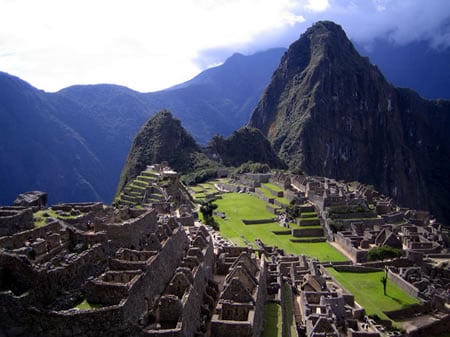
Machu Picchu was built in the classical Inca style, with polished dry-stone walls. Its three primary structures are the Intihuatana, the Temple of the Sun, and the Room of the Three Windows. Most of the outlying buildings have been reconstructed in order to give tourists a better idea of how they originally appeared. By 1976, thirty percent of Machu Picchu had been restored and restoration continues to this day.
Machu Picchu was declared a Peruvian Historic Sanctuary in 1981 and a UNESCO World Heritage Site in 1983. In 2007, Machu Picchu was voted one of the New Seven Wonders of the World in a worldwide Internet poll.
Etymology
In the Quechua language, machu means “old” or “old person”, while pikchu means “peak; mountain or prominence with a broad base that ends in sharp peaks”, hence the name of the site means “old peak”.
History
Machu Picchu was built around 1450, at the height of the Inca. Its construction appears to date to the period of the two great Inca rulers, Pachacutec Inca Yupanqui (1438–71) and Túpac Inca Yupanqui (1472–93). It was abandoned just over 100 years later, in 1572, as a belated result of the Spanish Conquest. It is possible that most of its inhabitants died from smallpox introduced by travellers before the Spanish conquistadors arrived in the area.
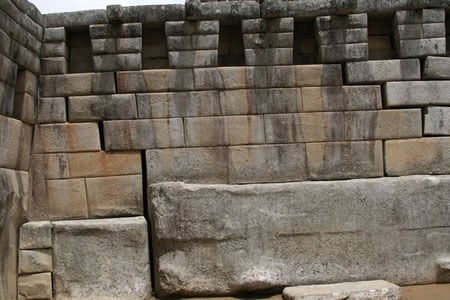
Although it was located only about 80 kilometers (50 mi) from the Inca capital in Cusco, the Spanish never found Machu Picchu and so did not plunder or destroy it, as they did many other sites. The conquistadors had notes of a place called Piccho, although no record of a Spanish visit exists. The types of sacred rocks defaced by the conquistadors in other locations are untouched at Machu Picchu.
Over the centuries, the surrounding jungle overgrew the site, and few outside the immediate area knew of its existence. The site may have been discovered and plundered in 1867 by a German businessman, Augusto Berns. Some evidence indicates that German engineer J. M. von Hassel arrived earlier. Maps show references to Machu Picchu as early as 1874.
In 1911 American historian and explorer Hiram Bingham travelled the region looking for the old Inca capital and was led to Machu Picchu by a local farmer. Bingham brought Machu Picchu to international attention and organized another expedition in 1912 to undertake major clearing and excavation. He returned in 1914 and 1915 to continue with excavation.
In 1981, Peru declared an area of 325.92 square kilometres (125.84 sq mi) surrounding Machu Picchu a “Historic Sanctuary”. In addition to the ruins, the sanctuary includes a large portion of the adjoining region, rich with the flora and fauna of the Peruvian Yungas and Central Andean wet puna ecoregions.
In 1983, UNESCO designated Machu Picchu a World Heritage Site, describing it as “an absolute masterpiece of architecture and a unique testimony to the Inca civilization”.
First American Expedition
Bingham was a lecturer at Yale University, although not a trained archaeologist. In 1909, returning from the Pan-American Scientific Congress in Santiago, he traveled through Peru and was invited to explore the Inca ruins at Choqquequirau in the Apurímac Valley. He organized the 1911 Yale Peruvian Expedition in part to search for the Inca capital, which was thought to be the city of Vitcos. He consulted Carlos Romero, a historian in Lima who showed him helpful references and Father Calancha’s Chronicle.
Armed with this information the expedition went down the Urubamba River. En route Bingham asked local people to show them Inca ruins. By the time they camped at Mandor Pampa, with Huayna Picchu 2000 feet above them on the opposite bank, they had already examined several ruins, but none fit the descriptions of Vitcos.

At Mandor Pampa, Bingham asked farmer and innkeeper Melchor Arteaga if he knew of any nearby ruins. Arteaga said he knew of excellent ruins on the top of Huayna Picchu. The next day, 24 July, Arteaga led Bingham and Sergeant Carrasco across the river on a log bridge and up the Huayna Picchu mountain. At the top of the mountain they came across a small hut occupied by a couple of Quechua, Richarte and Alvarez, who were farming some of the original Machu Picchu agricultural terraces that they had cleared four years earlier. Alvarez’s 11-year-old son, Pablito, led Bingham along the ridge to the main ruins.
The ruins were mostly covered with vegetation except for the cleared agricultural terraces and clearings used by the farmers as vegetable gardens. Because of the vegetation Bingham was not able to observe the full extent of the site. He took preliminary notes, measurements and photographs, noting the fine quality of Inca stonework of several principal buildings. Bingham was unclear about the original purpose of the ruins, but decided that there was no indication that it matched the description of Vitcos.
The expedition continued down the Urubamba and up the Vilcabamba Rivers examining all the ruins they could find. Guided by locals Bingham rediscovered and correctly identified the site of the old Inca capital, Vitcos (then called Rosaspata), and the nearby temple of Chuquipalta. He then crossed a pass and into the Pampaconas Valley where he found more ruins heavily buried in the jungle undergrowth at Espíritu Pampa, which he named “Eromboni Pampa”. As was the case with Machu Picchu, the site was so heavily overgrown that Bingham could only note a few of the buildings. In 1964, Gene Savoy further explored the ruins at Espiritu Pampa and revealed the full extent of the site, identifying it as Vilcabamba Viejo where the Incas fled after the Spanish drove them from Vitcos.
On the return of the expedition up the Urubamba River, Bingham sent two men to clear and map the site he referred to as Machu Picchu. As Bingham failed to identify the ruins at Espiritu Pampa as Vilcabamba Viejo, he erroneously theorized that Machu Picchu was Vilcabamba Viejo. Machu Picchu features spectacular workmanship and a dramatic site, while Vilcabamba was built while the short-lived remnant Neo-Inca State was being vanquished by the Spanish; it was built quickly and features crude workmanship.

Bingham returned to Machu Picchu in 1912 under the sponsorship of Yale University and National Geographic and with full support of Peruvian President Leguia. The expedition undertook a four-month clearing of the site with local labor, which was expedited with the support of the Prefect of Cuzco. Excavation started in 1912 with further excavation undertaken in 1914 and 1915. Bingham focused on Machu Picchu because of its fine Inca stonework and well-preserved nature, which had lain undisturbed since the site was abandoned. None of Bingham’s several hypotheses explaining the site held up. During his studies, he carried various artifacts back to Yale. One prominent artifact was a set of 15th-century, ceremonial Incan knives made from bismuth bronze; they are the earliest known artifact containing this alloy.
Although local institutions initially welcomed the exploration, they soon accused Bingham of legal and cultural malpractice. Rumors arose that the team was stealing artifacts and smuggling them out of Peru through Bolivia. (In fact, Bingham removed many artifacts, but openly and legally; they were deposited in the Yale University Museum.) Local press perpetuated the accusations, claiming that the excavation harmed the site and deprived local archaeologists of knowledge about their own history. Landowners began to demand rent from the excavators. By the time Bingham and his team left Machu Picchu, locals had formed coalitions to defend their ownership of Machu Picchu and its cultural remains, while Bingham claimed the artifacts ought to be studied by experts in American institutions.
Human Sacrifice and Mysticism
Little information describes human sacrifices at Machu Picchu, though many sacrifices were never given a proper burial, and their skeletal remains succumbed to the elements. However, there is evidence that retainers were sacrificed to accompany a deceased noble in the afterlife. Animal, liquid and dirt sacrifices to the gods were much more common, made at the Altar of the Condor. The tradition is upheld by members of the New Age Andean religion.
Geography
Machu Picchu lies in the southern hemisphere, 13.164 degrees south of the equator. It is 80 kilometres (50 miles) northwest of Cusco, on the crest of the mountain Machu Picchu, located about 2,430 metres (7,970 feet) above mean sea level, over 1,000 metres (3,300 ft) lower than Cusco, which has an elevation of 3,600 metres (11,800 ft). As such, it had a milder climate than the Inca capital. It is one of the most important archaeological sites in South America, one of the most visited tourist attractions in Latin America and the most visited in Peru.
Machu Picchu has wet and dry seasons, with the majority of annual rain falling from October through to April.
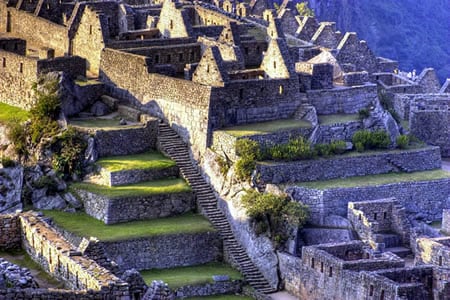
Machu Picchu is situated above a bow of the Urubamba River, which surrounds the site on three sides, where cliffs drop vertically for 450 metres (1,480 ft) to the river at their base. The area is subject to morning mists rising from the river. The location of the city was a military secret, and its deep precipices and steep mountains provided natural defenses. The Inca Bridge, an Inca grass rope bridge, across the Urubamba River in the Pongo de Mainique, provided a secret entrance for the Inca army. Another Inca bridge was built to the west of Machu Picchu, the tree-trunk bridge, at a location where a gap occurs in the cliff that measures 6 metres (20 ft). It could be bridged by two tree trunks, but with the trees removed, there was a 570 metres (1,870 ft) fall to the base of the cliffs.
The city sits in a saddle between the two mountains Machu Picchu and Huayna Picchu, with a commanding view down two valleys and a nearly impassable mountain at its back. It has a water supply from springs that cannot be blocked easily, and enough land to grow food for about four times as many people as ever lived there. The hillsides leading to it were terraced, to provide more farmland to grow crops, and to steepen the slopes that invaders would have to ascend. The terraces reduced soil erosion and protected against landslides. Two high-altitude routes from Machu Picchu cross the mountains back to Cusco, one through the Sun Gate, and the other across the Inca bridge. Both could be blocked easily, should invaders approach along them.
Site
Layout
The site is roughly divided into an urban sector and an agricultural sector, and into an upper town and a lower town. The temples are in the upper town, the warehouses in the lower.

The architecture is adapted to the mountains. Approximately 200 buildings are arranged on wide parallel terraces around an east-west central square. The various compounds, called kanchas, are long and narrow in order to exploit the terrain. Sophisticated channeling systems provided irrigation for the fields. Stone stairways set in the walls allowed access to the different levels across the site. The eastern section of the city was probably residential. The western, separated by the square, was for religious and ceremonial purposes. This section contains the Torreón, the massive tower which may have been used as an observatory.
Located in the first zone are the primary archaeological treasures: the Intihuatana, the Temple of the Sun and the Room of the Three Windows. These were dedicated to Inti, their sun god and greatest deity.
The Popular District, or Residential District, is the place where the lower-class people lived. It includes storage buildings and simple houses.
The royalty area, a sector for the nobility, is a group of houses located in rows over a slope; the residence of the amautas (wise persons) was characterized by its reddish walls, and the zone of the ñustas (princesses) had trapezoid-shaped rooms. The Monumental Mausoleum is a carved statue with a vaulted interior and carved drawings. It was used for rites or sacrifices.
The Guardhouse is a three-sided building, with one of its long sides opening onto the Terrace of the Ceremonial Rock. The three-sided style of Inca architecture is known as the wayrona style.
In 2005 and 2009, the University of Arkansas made detailed laser scans of the entire site and of the ruins at the top of the adjacent Huayna Picchu mountain. The scan data is available online for research purposes.
Intihuatana Stone
The Intihuatana stone is one of many ritual stones in South America. These stones are arranged to point directly at the sun during the winter solstice. The name of the stone (perhaps coined by Bingham) derives from Quechua language: inti means “sun”, and wata-, “to tie, hitch (up)”. The suffix -na derives nouns for tools or places. Hence Intihuatana is literally an instrument or place to “tie up the sun”, often expressed in English as “The Hitching Post of the Sun”. The Inca believed the stone held the sun in its place along its annual path in the sky. The stone is situated at 13°9’48” S. At midday on 11 November and 30 January, the sun stands almost exactly above the pillar, casting no shadow. On 21 June, the stone casts the longest shadow on its southern side, and on 21 December a much shorter shadow on its northern side.
Inti Mach’ay and the Royal Feast of the Sun
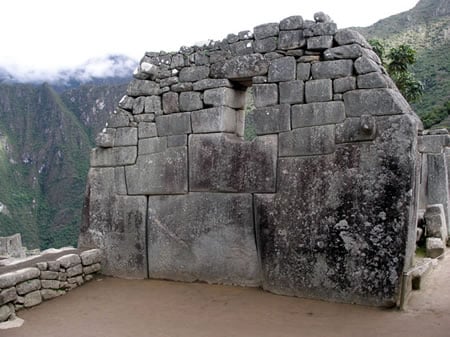
Inti Mach’ay is a special cave used to observe the Royal Feast of the Sun. This festival was celebrated during the Incan month of Qhapaq Raymi. It began earlier in the month and concluded on the December solstice. On this day, noble boys were initiated into manhood by an ear-piercing ritual as they stood inside the cave and watched the sun rise.
Architecturally, Inti Mach’ay is the most significant structure at Machu Picchu. Its entrances, walls, steps and windows are some of the finest masonry in the Incan Empire. The cave also includes a tunnel-like window unique among Incan structures, which was constructed to only allow sunlight into the cave during several days around the December solstice. For this reason, the cave was inaccessible for much of the year. Inti Mach’ay is located on the eastern side of Machu Picchu, just north of the “Condor Stone.” Many of the caves surrounding this area were prehistorically used as tombs, yet there is no evidence that Mach’ay was a burial ground.
Construction
The central buildings use the classical Inca architectural style of polished dry-stone walls of regular shape. The Incas were masters of this technique, called ashlar, in which blocks of stone are cut to fit together tightly without mortar.
The section of the mountain where Machu Picchu was built provided various challenges that the Incas solved with local materials. One issue was the seismic activity due to two fault lines. It made mortar and similar building methods nearly useless. Instead, the Inca mined stones from the quarry at the site, lined them up and shaped them to fit together perfectly, stabilizing the structures. Inca walls have many stabilizing features: doors and windows are trapezoidal, narrowing from bottom to top; corners usually are rounded; inside corners often incline slightly into the rooms; and outside corners were often tied together by “L”-shaped blocks; walls are offset slightly from row to row rather than rising straight from bottom to top.
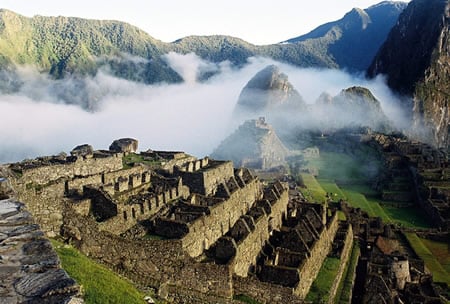
Heavy rainfall required terraces and stone chips to drain rain water and prevent mud slides, landslides, erosion and flooding. Terraces were layered with stone chips, sand, dirt and top soil, to absorb water and prevent it from running down the mountain. Similar layering protected the large city center from flooding. Multiple canals and reserves provide water throughout the city that could be supplied to the terraces for irrigation and to prevent erosion and flooding.
The Incas never used wheels in a practical way, although its use in toys shows that they knew the principle. Its use in engineering may have been limited due to the lack of strong draft animals, steep terrain and dense vegetation. The approach to moving and placing the enormous stones remains uncertain, probably involving hundreds of men to push the stones up inclines. A few stones have knobs that could have been used to lever them into position; after which they were generally sanded away, with a few overlooked.
Roads and Transportation
The Inca road system included a route to the Machu Picchu region. The people of Machu Picchu were connected to long-distance trade, as shown by non-local artifacts found at the site. For example, Bingham found unmodified obsidian nodules at the entrance gateway. In the 1970s, Burger and Asaro determined that these obsidian samples were from the Titicaca or Chivay obsidian source, and that the samples from Machu Picchu showed long-distance transport of this obsidian type in pre-Hispanic Peru.
Thousands of tourists walk the Inca Trail to visit Machu Picchu each year. They congregate at Cusco before starting on the one-, two-, four- or five-day journey on foot from Kilometer 82 (or 77 or 85, four/five-day trip) or Kilometer 104 (one/two-day trip) near the town of Ollantaytambo in the Urubamba valley, walking up through the Andes to the isolated city.
